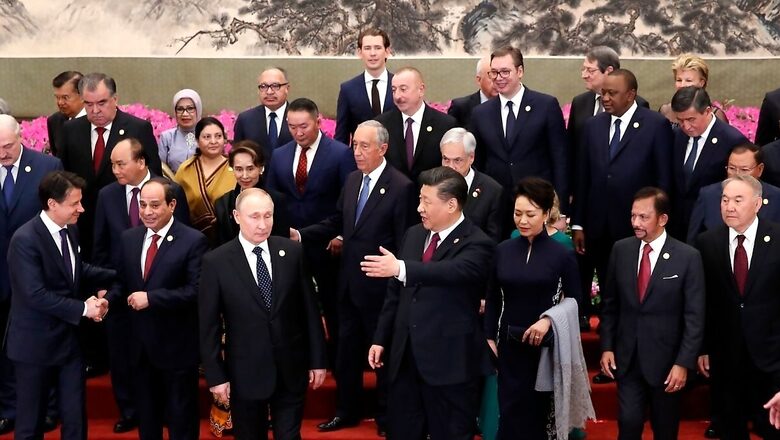
views
China has kicked off a summit marking the 10th anniversary of its Belt and Road Initiative, an ambitious project to boost connectivity, build infrastructure and trade across the world.
Representatives from 130 countries gather for a summit in Beijing to mark a decade of the project, in which Beijing has poured hundreds of billions of dollars to power the construction of bridges, ports, highways, power plants and telecoms projects.
However, the project is also marred in controversy as the project after a decade has left big debts and raised environmental concerns. The initiative has built power plants, roads, railroads and ports around the world and deepened China’s relations with Africa, Asia, Latin America and the Mideast. It is a major part of Chinese President Xi Jinping’s push for China to play a larger role in global affairs.
WHAT IS THE BELT AND ROAD INITIATIVE?
Called “One Belt, One Road” in Chinese, the Belt and Road Initiative started as a program for Chinese companies to build transportation, energy and other infrastructure overseas funded by Chinese development bank loans.
The stated goal was to grow trade and the economy by improving China’s connections with the rest of the world in a 21st-century version of the Silk Road trading routes from China to the Middle East and onto Europe.
Xi unveiled the concept in broad terms on visits to Kazakhstan and Indonesia in 2013 and it took shape in the ensuing years, driving the construction of major projects from railroads in Kenya and Laos to power plants in Pakistan and Indonesia.
HOW BIG IS IT?
A total of 152 countries have signed a BRI agreement with China, though Italy, the only western European country to do so, is expected to drop out when it comes time to renew in March of next year. Italy suffered a loss as the trade deficit with China more than doubled since Italy joined in 2019.
China became a major financer of development projects under BRI, on par with the World Bank. The Chinese government says the initiative has launched more than 3,000 projects and “galvanized” nearly $1 trillion in investment.
China filled a gap left as other lenders shifted to areas such as health and education and away from infrastructure after coming under criticism for the impact major building projects can have on the environment and local communities, said Kevin Gallagher, the director of the Boston University Global Development Policy Center.
KEY CONCERNS
The Chinese-financed projects have faced similar criticism, from displacing populations to adding tons of climate-changing greenhouse gases to the atmosphere.
Chinese development banks provided money for the BRI projects as loans, and some governments have been unable to pay them back. China said this month that BRI participants owe more than $300 billion to the Export-Import Bank of China.
That has led to allegations by Western countries that China was engaging in “debt trap” diplomacy where they knew that the borrowing company would default on loans and in turn allowing Chinese interests to take control of the assets. A pertinent example in this case is Sri Lankan port that the government ended up leasing to a Chinese company for 99 years.
Others say that China did not make the bad loans intentionally and now China development banks are pulling back. Chinese development loans have already plummeted in recent years as the banks have become more cautious about lending.
Chinese loans have been a major contributor to the huge debt burdens that are weighing on economies in countries such as Zambia and Pakistan. Sri Lanka said last week that it had reached an agreement with the Export-Import Bank of China on key terms and principles for restructuring its debt as it tries to emerge from an economic crisis that toppled the government last year.
WHAT’S NEXT FOR BRI?
Future BRI projects are likely not only to be smaller and greener but also rely more on investment by Chinese companies than on development loans to governments.
Christoph Nedopil, director of the Asia Institute at Griffith University in Australia, believes that China will still undertake some large projects, including high-visibility ones such as railways and others, including oil and gas pipelines, that have a revenue stream to pay back the investment.
A recent example is the launch of a Chinese high-speed railway in Indonesia with much fanfare in both countries.
ENVIRONMENTAL CONCERNS
The initiative has also drawn scrutiny for its massive carbon footprint and the environmental degradation caused by massive infrastructure projects.
The development of mega ports, pipelines, railways and highways could render the Paris climate goals unreachable, researchers from China, the United States and the United Kingdom warned in 2019.
Meanwhile, a report by experts at Boston University’s Global Development Policy warned that Chinese-led hard infrastructure projects carry higher risks to indigenous lands and ecosystems due to the country’s “relative newcomer status in global development finance and its early stages of developing environmental and social risk management due diligence policies and procedures”.
China has sought to allay environmental fears, promising in 2021 not to build new coal power plants abroad, though many previously agreed projects are still in progress.
These range from wind and solar farms to factories for electric vehicle batteries, such as a huge lithium-ion battery plant that has stirred environmental concerns in BRI-partner Hungary.
(With inputs from AP)
















Comments
0 comment